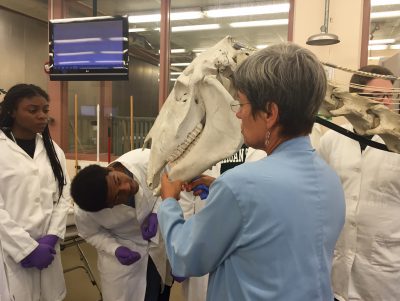Chris Kuechle, Class of 2019, shares his experience as the College's first student ambassador.
Summer is a special time for veterinary students at Michigan State University’s College of Veterinary Medicine. First and second year students get the summer “off” to conduct research, gain more experience in a clinical setting, travel abroad for education, or follow almost any other opportunity you can imagine.
This summer, in my role as the College’s first student ambassador, I have been able to see a lot that happens behind the scenes at the College of Veterinary Medicine. For four months, I gave a veterinary student’s perspective as faculty and staff reviewed and revised procedures in admissions, student affairs, and diversity and inclusion. As student ambassador, I also helped with College summer programs like SpartanQuest. This opportunity as ambassador has allowed me to better understand administrative processes while reinforcing some of what I learned during my first year—and giving me the opportunity to share it with interested youth.
My favorite event this summer was SpartanQuest. This is a collaborative event of our Office of Diversity and Inclusion and the Horizons-Upward Bound (HUB) program at Cranbrook, a private high school in Bloomfield Hills, Michigan. The HUB program prepares students in the metro Detroit area to enter and succeed in post-secondary education through a year-round academic program.

The SpartanQuest program allowed us to highlight veterinary medicine to promising students from Detroit high schools. HUB students from Cranbrook visited Michigan State University, and our college hosted them for two afternoons.
On the first day, I worked with Dr. Jen Roberts to set up a presentation, preparing reproductive tracts from heifers and cows. Given their urban background, many of these students had little to no experience with cows, and even less with cows’ reproductive anatomy and physiology. A few had to take a breather as we dug into the details of these tracts. The presentation was educational for the students and a great review of my own knowledge.
The next day we worked with Dr. Ioana Sonea, known by all first year students as moderator of our anatomy courses. For this lab, she rolled out a full horse skeleton—the look on the kids’ faces was amazing when Dr. Sonea’s lab presentation compared the skeletal structure of humans, dogs, and horses; whose bones are mostly the same bones, just evolved for different purposes. We also covered the innate respiratory problems prominent in short-nosed dog breeds like pugs. I could tell this lab was more appealing, probably because these students typically interact with dogs more often than cows.
SpartanQuest was an excellent opportunity not only to reinforce the knowledge I’ve gained this past year, but to educate young people about the opportunities and many facets of veterinary medicine, whether they enjoy cows, dogs, cats, or even public health or research. To see the eager young faces was a reminder to me of an earlier point in my long journey toward becoming a veterinarian. I was happy for the opportunity to participate and help out in this program, I hope I can do it again next year.
